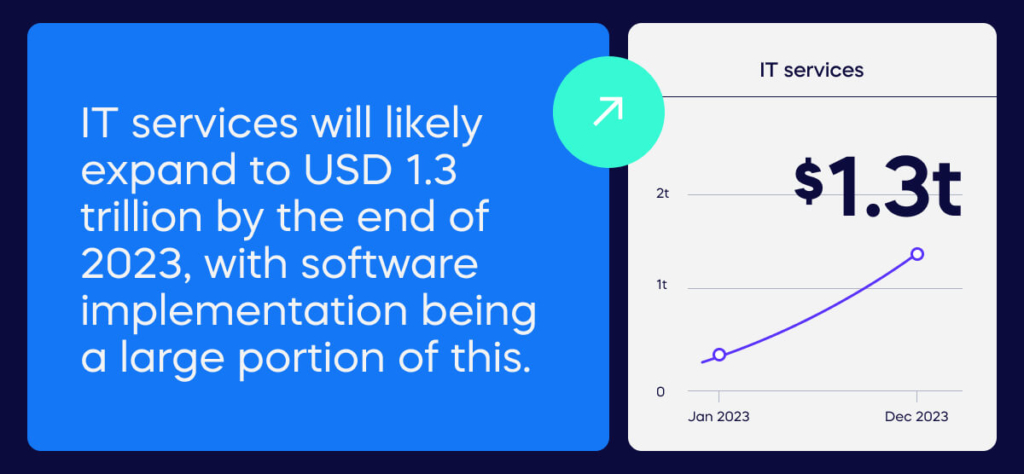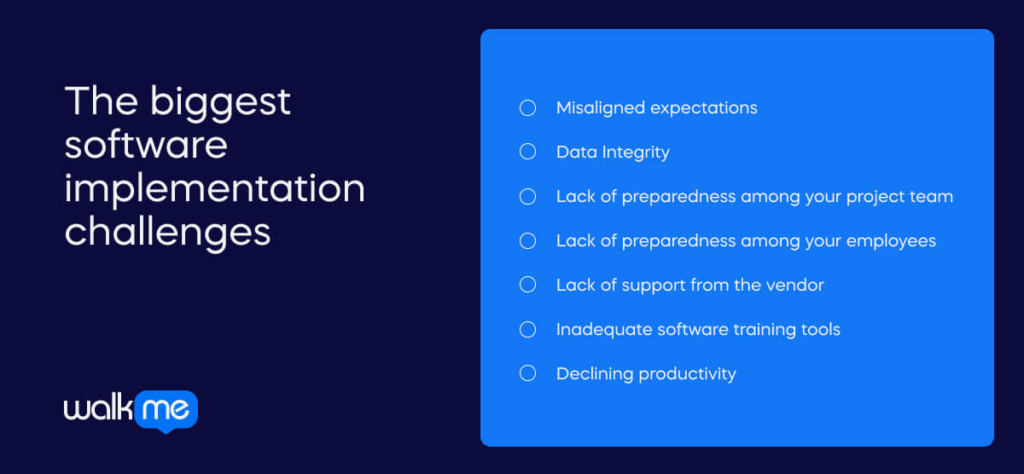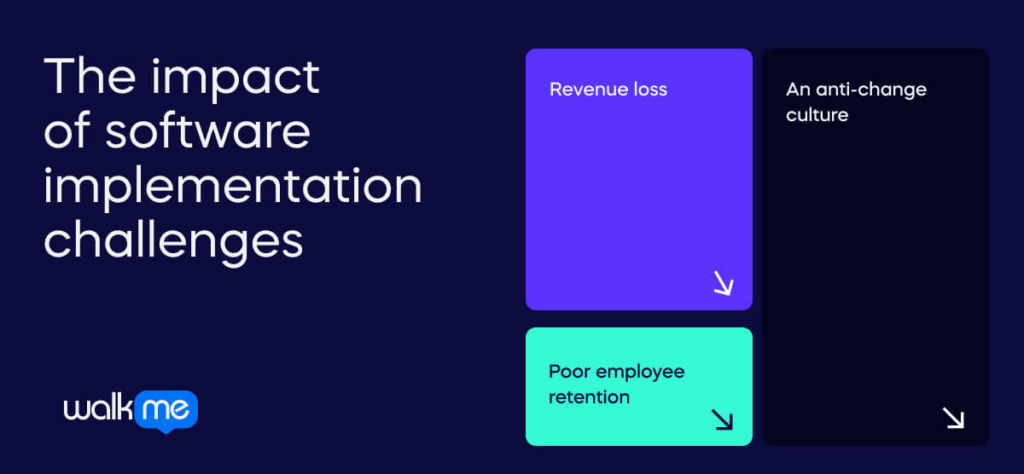Have you ever experienced expectations quickly followed by disappointment using a new software solution that doesn’t integrate within your enterprise as you hoped?
Procurement is one thing, but software implementation challenges can hinder your progress and set you back months, costing time and money and leaving staff burnt out and ready to look for the door, affecting employee retention.
IT services will likely expand to USD 1.3 trillion by the end of 2023, with software implementation being a large portion of this. Don’t waste resources by failing to tackle software implementation challenges for the fastest ROI on your digital tools.

To help you understand software implementation challenges and how to solve them, we will explore the following topics:
- How you can avoid the biggest software implementation challenges
- The impact and significance of software implementation challenges
What are the biggest software implementation challenges?
A successful implementation starts with a clearly defined plan. This includes understanding what the software can deliver, adequately preparing your project team, anticipating employee needs, and more.
The more prepared you are, the less of a threat common software implementation challenges will pose.
Here, we will discuss some of the biggest software implementation challenges and how to avoid them.

1. Misaligned expectations
Your software implementation team will include a variety of internal stakeholders, such as a project manager, team leaders, product managers, digital adoption experts, and subject matter experts for enterprise software projects.
The project team will work closely with the vendor to implement the software system, including developers, designers, and customer success managers.
The software vendor needs to be transparent and honest about what they can realistically deliver throughout the implementation process.
For example, if you expect them to be very hands-on and receive a less attentive level of service, there might be a clash.
If you were under the impression that the software had a desired capability, but it doesn’t, that could create issues down the line.
To ensure your expectations are met during the implementation process, there must be strong communication between your internal project team and the vendor.
By defining the milestones and deliverables required during the planning stage, meeting expectations in the implementation stage will be much smoother.
2. Data Integrity
Most often, your software implementation will require data migration from an existing system to a new one.
Ensuring data integrity throughout the process will be critical, so understanding which data can be translated across systems and which cannot should be a top consideration.
By understanding the level of interoperability between the two systems, you’ll be better prepared to ensure the data is secure, no data gets lost or left behind in the migration, and privacy standards are upheld to maintain data integrity throughout the implementation process.
The danger with not keeping a close eye on data integrity during the migration is that you could lose important customer information. The data could be compromised and unreliable if information is lost or misconstrued during a transfer.
During the implementation phase, the project team must continue to verify the integrity of the data, potentially involving a third party to moderate and ensure requirements are met.
3. Lack of preparedness among your project team
The project team must be aligned on overall goals, processes, and timelines. Each member must be prepared to represent the interests of their department or team and work together to develop the implementation plan.
Preparing for the actual roll-out includes determining how much on-premise support the vendor will need to provide during the first days and weeks, depending on the roll-out scale.
Another responsibility of the project team is setting up a framework for identifying and addressing common user problems.
Doing so could include setting up new communication channels between users and the project team and enlisting a solution that provides analytics on user engagement and process completion.
In an interview with WalkMe, CIO of enterprise software company Red Hat, Mike Kelly, was quoted saying, “Our job as leaders is to deeply understand what our business model is, how it works, how efficient it is, and then introduce and leverage technologies, and get everybody rallied around adopting them in a way that helps mitigate any issues associated with that.”
With such insights, you’ll have a clear and accurate view of the most prominent usability challenges and be able to implement a solution swiftly.
4. Lack of preparedness among your employees
When implementing new software, there may be resistance from employees who are happy with the existing system and do not want to learn new processes.
It is crucial to prepare staff for the changes fully. Set some time ahead of the implementation to show them the benefits of the new software. Clarify why it’s necessary for their day-to-day and how it will improve the efficiency and quality of their work.
That way, when it’s time for them to start learning how to use the new software, they will avoid digital adoption mistakes and embrace it.
5. Lack of support from the vendor
Aside from being contractually obligated to oversee the implementation, the software vendor should be seen as a partner in the project. Their on-hand expertise will be crucial in ensuring a smooth transition.
Open communication lines can help mitigate the feeling that the vendor disappears after the initial roll-out.
The vendor’s customer support representative and development team should be available to answer specific questions, provide expertise and support where needed, and work alongside your IT department to resolve any issues quickly.
Establishing a good rapport with your customer support representative is a great first step. Creating a friendly relationship will make working together to solve issues much easier and less stressful.
6. Inadequate software training tools
Training should be one of the top priorities when implementing new software. After all, if staff don’t know how to use it, what’s the point in having it? Employees need to understand the software’s potential value and how to realize that value daily.
The project team’s role is two-fold. First, to communicate the value of the new software and second, to develop an effective onboarding plan.
This action should include a system for getting employees up to speed on completing core processes and utilizing features confidently.
It may be helpful to appoint “super-users” who can be on hand to answer questions and help resolve issues. After the initial onboarding, continuous employee training on new features and workflows must be provided.
A Digital Adoption Platform is a proven way to onboard new software users quickly and with minimal disruption. By guiding users through step-by-step instructions and contextual learning, DAPs enable “learning in the flow of work.”
That means employees can learn to complete unfamiliar processes independently as they do their work. Instead of wasting time in the classroom and attempting to recall everything they learned, a DAP ensures all necessary information and resources are always accessible.
7. Declining productivity
There is a high risk of declining productivity during a software implementation. Not only is this a threat to the ROI of the new software, but it can also lead to decreased morale among staff.
DAPs can help you prevent this productivity drop by shortening employees’ time-to-competency or the amount it takes to complete tasks optimally, leading to faster digital adoption of new digital tools.
A DAP achieves this through contextual learning employee training, which provides tailored guidance and real-time support based on individuals’ needs.
It automatically assesses factors such as experience, role, and department, as well as what task an employee is trying to perform, to help employees complete their work and maintain productivity.
What is the impact of software implementation challenges?

It may be easy to sweep the significance of software implementation challenges under the rug if you can’t see the bigger picture.
Consider the below list detailing the impact of software implementation challenges on ROI, company culture, and resource optimization.
Revenue loss
Change is costly, especially when it fails.
This point is especially true regarding software implementation, as it wastes time when IT staff and employees in different departments try to use new software that is not functioning as expected, which always means wasted money.
Successful software implementation, on the other hand, occurs quickly and saves money as staff integrate it into their workflow efficiently.
An anti-change culture
If you implement software poorly, especially more than once, staff become frustrated and begin to resent change, fostering negative attitudes toward any future digital transformation or change initiative. These experiences can also cause technostress.
This environment makes innovation, creativity, and progress impossible.
Tackling software implementation challenges proactively helps staff view change positively, streamlining future changes and resulting in faster ROI.
Poor employee retention
Revenue loss and an anti-change culture caused by a failure to tackle software implementation challenges often result in frustration, eventually leading to staff departing their organization.
However, enterprise software projects that organizations implement successfully and quickly give staff a unified vision for the future, increasing innovation and employee well-being.
Remember, the devil is in the detail
Implementing a new software platform is a big task that requires detailed planning to ensure smooth execution. If your planning is effective, it should mean that your team is prepared correctly, the software complies with the required regulations, and appropriate expectations have been set.

Allow time for proper onboarding so your employees are comfortable and confident using the software. Training should be seen as a continual process with detailed step-by-step guidance offered at the point of need to ensure minimal disruption to people’s work.

